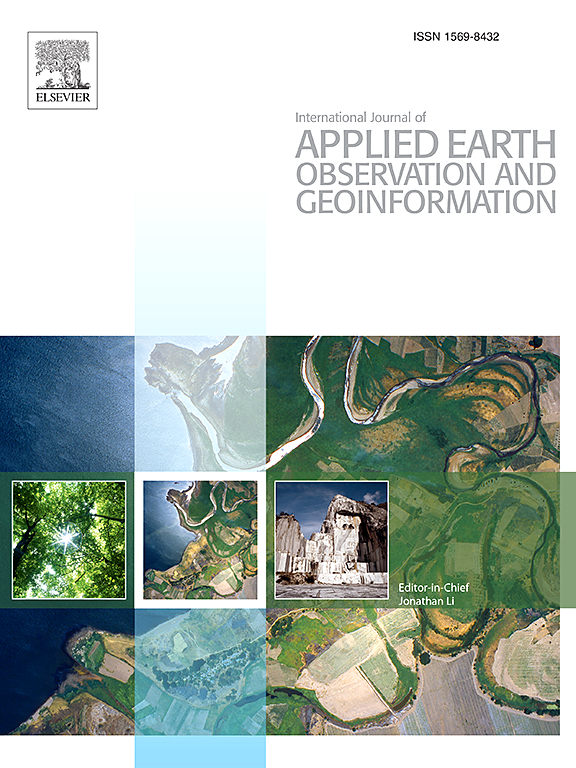TEBS:基于结构化状态空间模型和门控关注的热红外高光谱图像分类的温度-发射率驱动波段选择
IF 8.6
Q1 REMOTE SENSING
International journal of applied earth observation and geoinformation : ITC journal
Pub Date : 2025-07-04
DOI:10.1016/j.jag.2025.104710
引用次数: 0
摘要
热红外高光谱图像(tir - hsi)提供了通常无法通过可见光图像获得的独特光谱见解,使其在土地覆盖分类和地质测绘等应用中具有不可估量的价值。然而,tir - hsi的高光谱冗余往往导致计算复杂度的增加和潜在的性能下降。为了解决这一问题,本文提出了一种结合结构化状态空间模型(SSM)和门控注意机制(GAM)的无监督温度发射率驱动波段选择方法(TEBS)用于ir - hsi分类。首先设计特征提取模块,分离地表温度(LST)和地表发射率(LSE)信息,结合超像素分割提取多尺度地表温度特征;随后,利用SSM和GAM开发了权重计算(WC)模块,通过顺序利用多尺度LST特征来生成鲁棒频带权重。最后,利用波段评估(BE)模块对波段选择结果进行评估,并对模型参数进行优化。在使用四种经典分类器的两个数据集上进行的实验比较表明,TEBS框架在分类精度上优于最先进的SOTA方法。这些结果强调了TEBS在推进热红外高光谱成像中土地覆盖分类方面的潜力。数据和代码将在https://github.com/Qu-NX/TEBS上公开。本文章由计算机程序翻译,如有差异,请以英文原文为准。
TEBS: Temperature–Emissivity–Driven band selection for thermal infrared hyperspectral image classification with structured State-Space model and gated attention
Thermal infrared hyperspectral images (TIR-HSIs) provide unique spectral insights that are often unattainable with visible imagery, making them invaluable for applications such as land cover classification and geological mapping. However, the high spectral redundancy in TIR-HSIs often leads to increased computational complexity and potential performance degradation. To address this issue, this paper proposed an unsupervised temperature–emissivity–driven band selection method (TEBS) for TIR-HSIs classification, which integrated a structured state-space model (SSM) and a gated attention mechanism (GAM). Specifically, a feature extraction (FE) module is firstly designed to separate land surface temperature (LST) and land surface emissivity (LSE) information, incorporating superpixel segmentation to extract multi-scale LST features. Subsequently, a weight computation (WC) module, leveraging SSM and GAM, is developed to generate robust band weights by sequentially leveraging multi-scale LST features. Finally, a band evaluation (BE) module is employed to assess the band selection results and optimize the model parameters. Experimental comparisons conducted on two datasets using four classic classifiers show that TEBS framework outperforms state-of-the-art (SOTA) methods in classification accuracy. These results underscore the potential of TEBS to advance land cover classification in thermal infrared hyperspectral imaging. The data and code will be made publicly available at: https://github.com/Qu-NX/TEBS.
求助全文
通过发布文献求助,成功后即可免费获取论文全文。
去求助
来源期刊

International journal of applied earth observation and geoinformation : ITC journal
Global and Planetary Change, Management, Monitoring, Policy and Law, Earth-Surface Processes, Computers in Earth Sciences
CiteScore
12.00
自引率
0.00%
发文量
0
审稿时长
77 days
期刊介绍:
The International Journal of Applied Earth Observation and Geoinformation publishes original papers that utilize earth observation data for natural resource and environmental inventory and management. These data primarily originate from remote sensing platforms, including satellites and aircraft, supplemented by surface and subsurface measurements. Addressing natural resources such as forests, agricultural land, soils, and water, as well as environmental concerns like biodiversity, land degradation, and hazards, the journal explores conceptual and data-driven approaches. It covers geoinformation themes like capturing, databasing, visualization, interpretation, data quality, and spatial uncertainty.
 求助内容:
求助内容: 应助结果提醒方式:
应助结果提醒方式:


